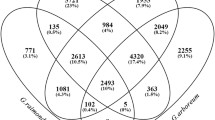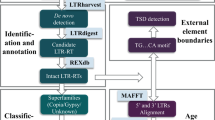Abstract
The long terminal repeat (LTR) retrotransposons are the most abundant class of transposable elements in plant genomes and play important roles in genome divergence and evolution. Their accumulation is the main factor influencing genome size increase in plants. Rice (Oryza sativa L.) is a model monocot and is the focus of much biological research due to its economic importance. We conducted a comprehensive survey of full-length LTR retrotransposons based on the completed genome of japonica rice variety Nipponbare (TIGR Release 5), with the newly published tool LTR-FINDER. The elements could be categorized into 29 structural domain categories (SDCs), and their total copy number identified was estimated at >6,000. Most of them were relatively young: more than 90% were less than 10 My. There existed a high level of activity among them as a whole at 0–1 Mya, but different categories possessed distinct amplification patterns. Most recently inserted elements were specific to the rice genome, while a few were conserved across species. This study provides new insights into the structure and evolutionary history of the full-length retroelements in the rice genome.



Similar content being viewed by others
References
Baucom RS, Estill JC, Leebens-Mack J, Bennetzen JL (2009) Natural selection on gene function drives the evolution of LTR retrotransposon families in the rice genome. Genome Res 19:243–254
Belancio VP, Hedges DJ, Deininger P (2008) Mammalian non-LTR retrotransposons: for better or worse, in sickness and in health. Genome Res 18:343–358
Biemont C, Vieira C (2005) What transposable elements tell us about genome organization and evolution: the case of Drosophila. Cytogenet Genome Res 110:25–34
Bowen NJ, Jordan IK (2002) Transposable elements and the evolution of eukaryotic complexity. Curr Issues Mol Biol 4:65–76
Casacuberta JM, Santiago N (2003) Plant LTR-retrotransposons and MITEs: control of transposition and impact on the evolution of plant genes and genomes. Gene 311:1–11
Chaparro C, Guyot R, Zuccolo A, Piegu B, Panaud O (2007) RetrOryza: a database of the rice LTR-retrotransposons. Nucleic Acids Res 35:D66–D70
Chen M, SanMiguel P, Bennetzen JL (1998) Sequence organization and conservation in sh2/a1-homologous regions of sorghum and rice. Genetics 148:435–443
Cheng Z, Buell CR, Wing RA, Gu M, Jiang J (2001) Toward a cytological characterization of the rice genome. Genome Res 11:2133–2141
Deininger PL, Moran JV, Batzer MA, Kazazian HH (2003) Mobile elements and mammalian genome evolution. Curr Opin Genet Dev 13:651–658
Devos KM, Brown JK, Bennetzen JL (2002) Genome size reduction through illegitimate recombination counteracts genome expansion in Arabidopsis. Genome Res 12:1075–1079
Diao X, Freeling M, Lisch D (2006) Horizontal transfer of a plant transposon. PLoS Biol 4:e5
Docking TR, Saade FE, Elliott MC, Schoen DJ (2006) Retrotransposon sequence variation in four asexual plant species. J Mol Evol 62:375–387
Finnegan DJ (1989) Eukaryotic transposable elements and genome evolution. Trends Genet 5:103–107
Gao L, McCarthy EM, Ganko EW, McDonald JF (2004) Evolutionary history of Oryza sativa LTR retrotransposons: a preliminary survey of the rice genome sequences. BMC Genom 5:18
Gaut BS, Morton BR, McCaig BC, Clegg MT (1996) Substitution rate comparisons between grasses and palms: synonymous rate differences at the nuclear gene Adh parallel rate differences at the plastid gene rbcL. Proc Natl Acad Sci USA 93:10274–10279
Hirochika H, Otsuki H, Yoshikawa M, Otsuki Y, Sugimoto K, Takeda S (1996) Autonomous transposition of the tobacco retrotransposon Tto1 in rice. Plant Cell 8:725–734
Hirochika H, Okamoto H, Kakutani T (2000) Silencing of retrotransposons in Arabidopsis and reactivation by the ddm1 mutation. Plant Cell 12:357–369
Hu FY, Tao DY, Sacks E, Fu BY, Xu P, Li J, Yang Y, McNally K, Khush GS, Paterson AH, Li ZK (2003) Convergent evolution of perenniality in rice and sorghum. Proc Natl Acad Sci USA 100:4050–4054
Jiao Y, Jia P, Wang X, Su N, Yu S, Zhang D, Ma L, Feng Q, Jin Z, Li L, Xue Y, Cheng Z, Zhao H, Han B, Deng XW (2005) A tiling microarray expression analysis of rice chromosome 4 suggests a chromosome-level regulation of transcription. Plant Cell 17:1641–1657
Kalendar R, Tanskanen J, Immonen S, Nevo E, Schulman AH (2000) Genome evolution of wild barley (Hordeum spontaneum) by BARE-1 retrotransposon dynamics in response to sharp microclimatic divergence. Pro Natl Acad Sci USA 97:6603–6607
Kashkush K, Khasdan V (2007) Large-scale survey of cytosine methylation of retrotransposons and the impact of readout transcription from long terminal repeats on expression of adjacent rice genes. Genetics 177:1975–1985
Kidwell MG, Lisch DR (2000) Transposable elements and host genome evolution. Trends Ecol Evol 15:95–99
Komatsu M, Shimamoto K, Kyozuka J (2003) Two-step regulation and continuous retrotransposition of the rice LINE-type retrotransposon Karma. Plant Cell 15:1934–1944
Langdon T, Seago C, Mende M, Leggett M, Thomas H, Forster JW, Jones RN, Jenkins G (2000) Retrotransposon evolution in diverse plant genomes. Genetics 156:313–325
Liu B, Wendel JF (2000) Retrotransposon activation followed by rapid repression in introgressed rice plants. Genome 43:874–880
Ma J, Bennetzen JL (2004) Rapid recent growth and divergence of rice nuclear genomes. Proc Natl Acad Sci USA 101:12404–12410
Ma J, Bennetzen JL (2006) Recombination, rearrangement, reshuffling, and divergence in a centromeric region of rice. Proc Natl Acad Sci USA 103:383–388
Ma J, Devos KM, Bennetzen JL (2004) Analyses of LTR-retrotransposon structures reveal recent and rapid genomic DNA loss in rice. Genome Res 14:860–869
Matyunina LV, Bowen NJ, McDonald JF (2008) LTR retrotransposons and the evolution of dosage compensation in Drosophila. BMC Mol Biol 9:55
McCarthy EM, Liu J, Lizhi G, McDonald JF (2002) Long terminal repeat retrotransposons of Oryza sativa. Genome Biol 3:0053
Meyers BC, Tingey SV, Morgante M (2001) Abundance, distribution, and transcriptional activity of repetitive elements in the maize genome. Genome Res 11:1660–1676
Nagaki K, Neumann P, Zhang D, Ouyang S, Buell CR, Cheng Z, Jiang J (2005) Structure, divergence, and distribution of the CRR centromeric retrotransposon family in rice. Mol Biol Evol 22:845–855
Okamoto H, Hirochika H (2001) Silencing of transposable elements in plants. Trends Plant Sci 6:527–534
Petrov DA (2001) Evolution of genome size: new approaches to an old problem. Trends Genet 17:23–28
Piegu B, Guyot R, Picault N et al (2006) Doubling genome size without polyploidization: Dynamics of retrotransposition-driven genomic expansions in Oryza australiensis, a wild relative of rice. Genome Res 16:1262–1269
Salse J, Bolot S, Throude M, Jouffe V, Piegu B, Quraishi UM, Calcagno T, Cooke R, Delseny M, Feuillet C (2008) Identification and characterization of shared duplications between rice and wheat provide new insight into grass genome evolution. Plant Cell 20:11
Soleimani VD, Baum BR, Johnson DA (2006) Quantification of the retrotransposon BARE-1 reveals the dynamic nature of the barley genome. Genome 49:389–396
Vicient CM, Jaaskelainen MJ, Kalendar R, Schulman AH (2001) Active retrotransposons are a common feature of grass genomes. Plant Physiol 125:1283–1292
Vitte C, Bennetzen JL (2006) Analysis of retrotransposon structural diversity uncovers properties and propensities in angiosperm genome evolution. Proc Natl Acad Sci USA 103:17638–17643
Vitte C, Panaud O (2003) Formation of solo-LTRs through unequal homologous recombination counterbalances amplifications of LTR retrotransposons in rice Oryza sativa L. Mol Biol Evol 20:528–540
Vitte C, Panaud O (2005) LTR retrotransposons and flowering plant genome size: emergence of the increase/decrease model. Cytogenet Genome Res 110:91–107
Vitte C, Panaud O, Quesneville H (2007) LTR retrotransposons in rice (Oryza sativa, L.): recent burst amplifications followed by rapid DNA loss. BMC Genom 8:218
Wang H, Liu JS (2008) LTR retrotransposon landscape in Medicago truncatula: more rapid removal than in rice. BMC Genom 9:382
Wawrzynski A, Ashfield T, Chen NW et al (2008) Replication of nonautonomous retroelements in soybean appears to be both recent and common. Plant Physiol 148:1760–1771
Wendel JF, Wessler SR (2000) Retrotransposon-mediated genome evolution on a local ecological scale. Proc Natl Acad Sci USA 97:6250–6252
Wessler SR (1996) Turned on by stress. Plant retrotransposons. Curr Biol 6:959–961
Wessler SR (2006) Transposable elements and the evolution of eukaryotic genomes. Proc Natl Acad Sci USA 103:17600–17601
Wicker T, Keller B (2007) Genome-wide comparative analysis of copia retrotransposons in Triticeae, rice, and Arabidopsis reveals conserved ancient evolutionary lineages and distinct dynamics of individual copia families. Genome Res 17:1072–1081
Wicker T, Sabot F, Hua-Van A, Bennetzen JL, Capy P, Chalhoub B, Flavell A, Leroy P, Morgante M, Panaud O (2007) Guidelines: a unified classification system for eukaryotic transposable elements. Nat Rev Genet 8:973–982
Xu JH, Messing J (2008) Diverged copies of the seed regulatory Opaque-2 gene by a segmental duplication in the progenitor genome of rice, sorghum, and maize. Mol Plant 1:760–769
Xu Z, Wang H (2007) LTR-FINDER: an efficient tool for the prediction of full-length LTR retrotransposons. Nucleic Acids Res 35:W265–W268
Acknowledgments
We thank Dr. M.A. Fullen for helpful suggestions and manuscript modification. We also thank Dr. Zhao Xu (Fudan University) for providing LTR-FINDER and for kindly helping us to use it. This work is supported by the National Basic Research Programme of China (2006CB100202), Scientific Foundation of the Education Ministry of China (307025), and the National Natural Science Foundation of China (30860161).
Author information
Authors and Affiliations
Corresponding author
Electronic supplementary material
Below is the link to the electronic supplementary material.
Rights and permissions
About this article
Cite this article
Xu, L., Zhang, Y., Su, Y. et al. Structure and evolution of full-length LTR retrotransposons in rice genome. Plant Syst Evol 287, 19–28 (2010). https://doi.org/10.1007/s00606-010-0285-2
Received:
Accepted:
Published:
Issue Date:
DOI: https://doi.org/10.1007/s00606-010-0285-2




